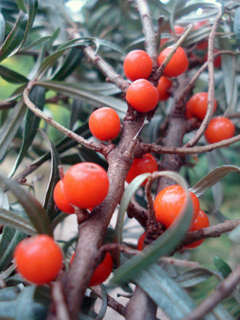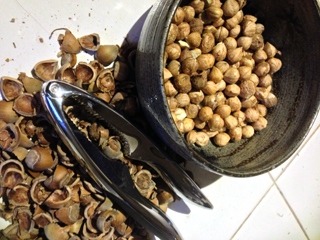 The seasons are changing, the mornings feel fresh and the nights are beginning to draw in. I love the fact that we are still getting the odd gloriously hot summery day so the seasons are blending to ease the process of the oncoming winter.
The seasons are changing, the mornings feel fresh and the nights are beginning to draw in. I love the fact that we are still getting the odd gloriously hot summery day so the seasons are blending to ease the process of the oncoming winter.
September was lovely. We picked plums and got some wine on the go, made a tart plum jam which was excellent with cheese and crackers and the figs off the tree were phenomenal this year. I made Italian cookies with fig, hazelnut and cloves, fig and stem ginger conserve and of course eating them straight off the tree!
 We’ve been lucky with our blackberries too – early, plump, juicy and delicious! Simple blackberry muffins went down a treat along with scones, cream and blackberry rose-scented geranium jam for an alternative cream tea. Surprisingly sea buckthorn was ripe and ready to pick too.
We’ve been lucky with our blackberries too – early, plump, juicy and delicious! Simple blackberry muffins went down a treat along with scones, cream and blackberry rose-scented geranium jam for an alternative cream tea. Surprisingly sea buckthorn was ripe and ready to pick too.
Normally I carefully prune a few berry-laden branches and take them home to freeze them so I can take the berries off the branches without them exploding everywhere but this time I must have timed it perfectly because almost all the berries I picked straight from the bushes stayed intact. My favourite thing to do with sea buckthorn is curd, but ice cream and a sharp sauce for fish are also well worth a go.
 So what is in stall for us in October? Pack a little rucksack with waterproofs, cosy jumper and a packed lunch (a hot and leaky pasty?) and get out there in search for October’s delights. There will no doubt still be blackberries about but I think of this month’s fruits as a little bit more hard core, such as haws from hawthorn, sloes, rowan berries and crab apples.
So what is in stall for us in October? Pack a little rucksack with waterproofs, cosy jumper and a packed lunch (a hot and leaky pasty?) and get out there in search for October’s delights. There will no doubt still be blackberries about but I think of this month’s fruits as a little bit more hard core, such as haws from hawthorn, sloes, rowan berries and crab apples.
Haws make fantastic ketchup by simmering them with water until soft, passing through a sieve and combining with vinegar, brown sugar and spices, sloes are best for gin (don’t forget to keep the spent, gin-soaked sloes for decadent chocolate truffles) and rowan berries make a sharp jelly or sauce for cold meats and cheeses.
Crab apples can be so varied from little mini versions of braeburn that can be caramelized with cinnamon to eat with vanilla ice cream, long red ones that almost look like rose hips or even small green, sharp ones that are like paint stripper. They are very useful for setting jelly because of their high pectin content but they can also make a good wine or even schnapps.
 Hazelnuts are nice and ripe – I remember doing a foraging walk with quite a few children on it. We found a good lot of hazelnuts on the ground and one guy in the group who was in to bushcraft got the kids to gather them up and find him a couple of large stones and he began cracking open the shells to the kids’ delight.
Hazelnuts are nice and ripe – I remember doing a foraging walk with quite a few children on it. We found a good lot of hazelnuts on the ground and one guy in the group who was in to bushcraft got the kids to gather them up and find him a couple of large stones and he began cracking open the shells to the kids’ delight.
There’s been a fair few fungi around (quite a tongue twister!) and we’ll be getting more through October, for example common puff balls, deceivers, boletes and shaggy inkcaps. If you are new to fungus foraging you must be so careful and 100{c8c3b3d140ed11cb7662417ff7b2dc686ffa9c2daf0848ac14f76e68f36d0c20} sure that you know exactly what species it is.
As I have said before, get to know edibles slowly and get to know them very well – this is very important with fungi. When you pick a mushroom having properly identified it, think of it as picking a fruit off the tree. In this case, the tree is the expanse of mycelium spreading under the ground, like branches of a tree. As with plants, fungi have specific traits that help you identify which family they are in and from there you can work out the genus and so on.
 Something I haven’t mentioned yet is hogweed seeds. I expect I’ll talk about hogweed in the spring when the new shoots are unfurling but for now I have to tell you about the seeds. Hogweed is in the carrot family which is one of the most difficult families to tackle as there are many lookalikes including many poisonous ones such as hemlock.
Something I haven’t mentioned yet is hogweed seeds. I expect I’ll talk about hogweed in the spring when the new shoots are unfurling but for now I have to tell you about the seeds. Hogweed is in the carrot family which is one of the most difficult families to tackle as there are many lookalikes including many poisonous ones such as hemlock.
Hogweed is very common, has fairly large leaves and round, flat papery seeds. Yes you’re right, hogweed is the plant whose sap can cause serious blisters when it comes in to contact with skin, and yes it gets worse in daylight but the young shoots and flowers buds are edible when cooked and at this time of the year, the seeds are an excellent spice which is reminiscent of coriander seed and orange zest. I use it for both sweet and savoury dishes, such as for ice cream, flapjacks and in dukkah.
Here is a cheeky peak at a recipe from my autumn foraging book which is not yet available but in the making. For other recipes and ideas, check out my winter and spring editions which are available now via my website www.nevermindtheburdocks.co.uk
Hazelnut liqueur
5 cups of shelled, toasted and roughly chopped hazelnuts
1 x 750ml bottle vodka
1 good handful of toasted flaked almonds
2 tsp dried angelica root
2 cups sugar
1 vanilla pod
3/4 cup of water
In a large jar with a lid such as a kilner jar combine all the ingredients except the sugar and water, splitting the vanilla pod and scraping out the seeds and adding the seeds and pod to the mixture. Put the lid on it, shake well and leave for a couple of months in a dark place, shaking occasionally. Heat the water and sugar until the sugar has dissolved. Leave to cool completely. Strain the hazelnut liquid, add the sugar syrup and drink or store (I’d drink it – it’s been a long enough wait!)
